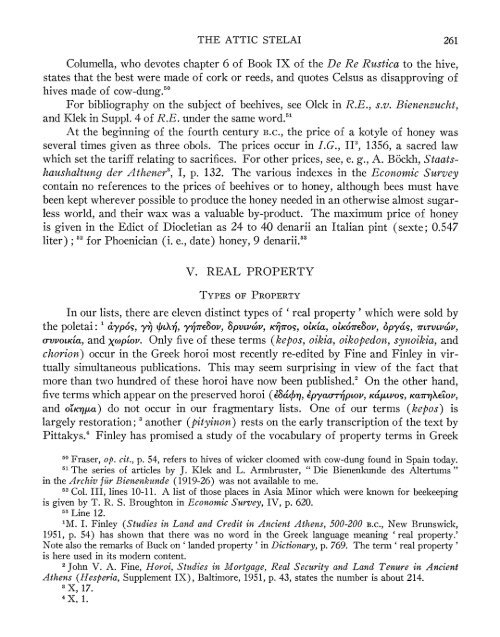the attic stelai - The American School of Classical Studies at Athens
the attic stelai - The American School of Classical Studies at Athens
the attic stelai - The American School of Classical Studies at Athens
You also want an ePaper? Increase the reach of your titles
YUMPU automatically turns print PDFs into web optimized ePapers that Google loves.
THE ATTIC STELAI 261<br />
Columella, who devotes chapter 6 <strong>of</strong> Book IX <strong>of</strong> <strong>the</strong> De Re Rustica to <strong>the</strong> hive,<br />
st<strong>at</strong>es th<strong>at</strong> <strong>the</strong> best were made <strong>of</strong> cork or reeds, and quotes Celsus as disapproving <strong>of</strong><br />
hives made <strong>of</strong> cow-dung.50<br />
For bibliography on <strong>the</strong> subject <strong>of</strong> beehives, see Olck in R.E., s.v. Bienenzucht,<br />
and Klek in Suppl. 4 <strong>of</strong> R.E. under <strong>the</strong> same word.5'<br />
At <strong>the</strong> beginning <strong>of</strong> <strong>the</strong> fourth century B.C., <strong>the</strong> price <strong>of</strong> a kotyle <strong>of</strong> honey was<br />
several times iII2 given as three obols. <strong>The</strong> prices occur in I.G., 1356, a sacred law<br />
which set <strong>the</strong> tariff rel<strong>at</strong>ing to sacrifices. For o<strong>the</strong>r prices, see, e. g., A. B6ckh, Sta<strong>at</strong>shaushaltung<br />
der A<strong>the</strong>ner3, I, p. 132. <strong>The</strong> various indexes in <strong>the</strong> Economic Survey<br />
contain no references to <strong>the</strong> prices <strong>of</strong> beehives or to honey, although bees must have<br />
been kept wherever possible to produce <strong>the</strong> honey needed in an o<strong>the</strong>rwise almost sugarless<br />
world, and <strong>the</strong>ir wax was a valuable by-product. <strong>The</strong> maximum price <strong>of</strong> honey<br />
is given in <strong>the</strong> Edict <strong>of</strong> Diocletian as 24 to 40 denarii an Italian pint (sexte; 0.547<br />
liter); 5 for Phoenician (i. e., d<strong>at</strong>e) honey, 9 denarii.53<br />
V. REAL PROPERTY<br />
TYPES OF PROPERTY<br />
In our lists, <strong>the</strong>re are eleven distinct types <strong>of</strong> ' real property' which were sold by<br />
<strong>the</strong> poletai: E Xypo%, Y?) qILXY, 'y-?TE8oV, 8pVLVW'v, KMiTo%, OLKUa, OLKorE8OV, opya6, mnrvdv,<br />
cTvVOLKLa, and Xoptov. Only five <strong>of</strong> <strong>the</strong>se terms (kepos, oikia, oikopedon, synoikia, and<br />
chorion) occur in <strong>the</strong> Greek horoi most recently re-edited by Fine and Finley in virtually<br />
simultaneous public<strong>at</strong>ions. This may seem surprising in view <strong>of</strong> <strong>the</strong> fact th<strong>at</strong><br />
more than two hundred <strong>of</strong> <strong>the</strong>se horoi have now been published.2 On <strong>the</strong> o<strong>the</strong>r hand,<br />
five terms which appear on <strong>the</strong> preserved horoi (E'8a5b, EpyacrTnp', Kcvos, Kaf7-XE'LOV,<br />
and O1'iKca) do not occur in our fragmentary lists. One <strong>of</strong> our terms (kepos) is<br />
largely restor<strong>at</strong>ion; 3 ano<strong>the</strong>r (pityinon) rests on <strong>the</strong> early transcription <strong>of</strong> <strong>the</strong> text by<br />
Pittakys.4 Finley has promised a study <strong>of</strong> <strong>the</strong> vocabulary <strong>of</strong> property terms in Greek<br />
50<br />
Fraser, op. cit., p. 54, refers to hives <strong>of</strong> wicker cloomed with cow-dung found in Spain today.<br />
51 <strong>The</strong> series <strong>of</strong> articles by J. Klek and L. Armbruster, " Die Bienenkunde des Altertums"<br />
in <strong>the</strong> Archiv fiir Bienenkunde (1919-26) was not available to me.<br />
52 Col. III, lines 10-11. A list <strong>of</strong> those places in Asia Minor which were known for beekeeping<br />
is given by T. R. S. Broughton in Economic Survey, IV, p. 620.<br />
53 Line 12.<br />
'M. I. Finley (<strong>Studies</strong> in Land and Credit in Ancient A<strong>the</strong>ns, 500-200 B.C., New Brunswick,<br />
1951, p. 54) has shown th<strong>at</strong> <strong>the</strong>re was no word in <strong>the</strong> Greek language meaning 'real property.'<br />
Note also <strong>the</strong> remarks <strong>of</strong> Buck on ' landed property ' in Dictionary, p. 769. <strong>The</strong> term 'real property'<br />
is here used in its modern content.<br />
2 John V. A. Fine, Horoi, <strong>Studies</strong> in Mortgage, Real Security and Land Tenure in Ancient<br />
A<strong>the</strong>ns (Hesperia, Supplement IX), Baltimore, 1951, p. 43, st<strong>at</strong>es <strong>the</strong> number is about 214.<br />
3X, 17.<br />
4X, 1.
















